Table of Contents[Hide][Show]
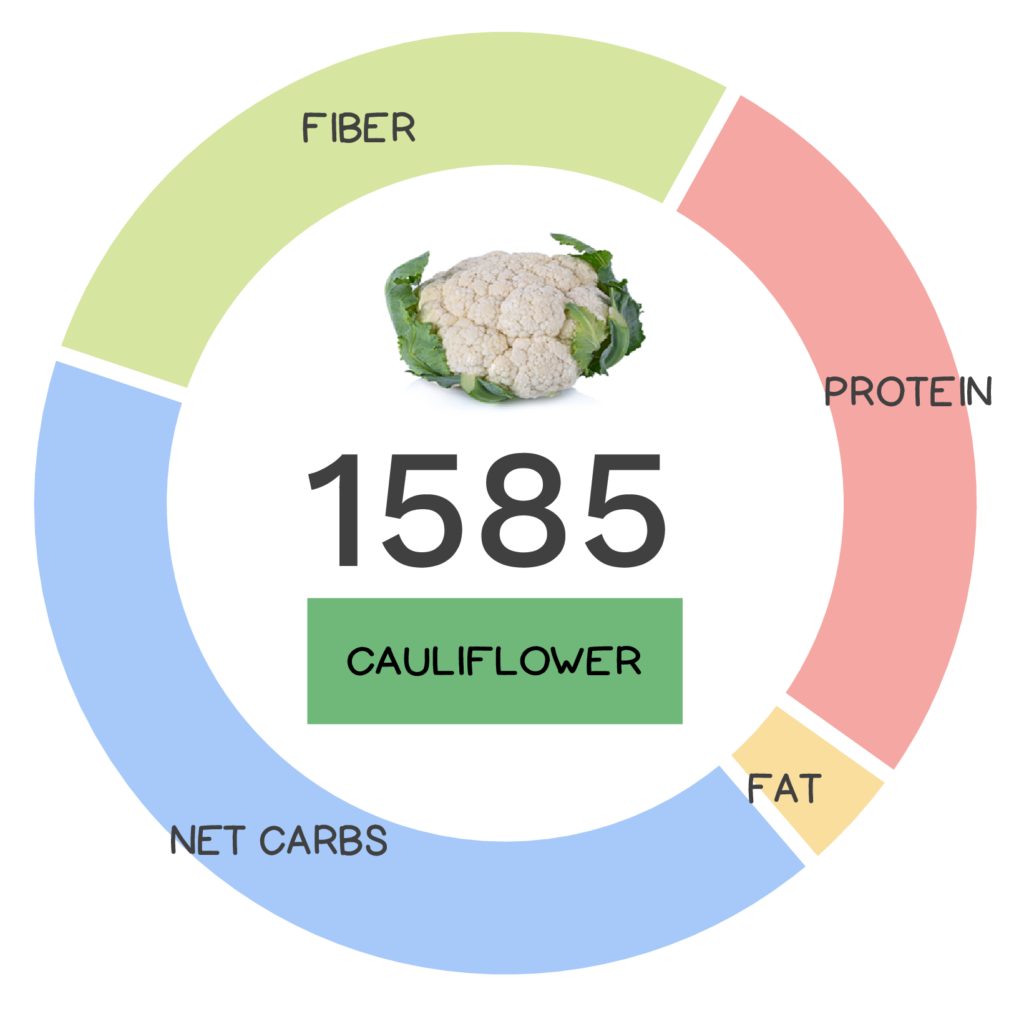
It’s safe to say we are currently in the midst of a cauliflower craze – this veggie is everywhere! It’s gaining celebrity status as a low-calorie, low-carb, gluten-free alternative to all sorts of foods including rice, flour and mashed potatoes. This cauli-craze has resulted in huge “growth” for this veggie – between 2017 and 2018 alone, cauliflower-based product sales increased by a whopping 71%! With all this hoopla, the cauliflower has become a symbol for attaining your wildest dreams –“If cauliflower can be pizza, then I can do anything!”
Between 2017 and 2018, cauliflower-based product sales increased by a whopping 71%!
This cruciferous vegetable is a member of the Brassicaceae family of plants that includes broccoli, Brussels sprouts, cabbage, collard greens, kale and kohlrabi. All members of this family originally descended from wild cabbage, evolving over thousands of years into cultivars with different characteristics enjoyed as numerous common veggies today. In the case of cauliflower, the plant developed large tender flowering heads forming the veggie we now know and love. The oldest record of cauliflower goes all the way back to 6th century BC, with its origins in Europe, while its name comes from the Italian ‘caoli fiori’, which means “cabbage flowers.”
There are hundreds of varieties of cauliflower, including not only the common white variety, but also orange, green, and purple versions of this veggie.
Today, there are hundreds of varieties of this veggie around the world, including the common white variety, but also orange varieties containing β-carotene (originating from a natural mutant found in Canada), green varieties sometimes referred to as ‘broccoflower’, and even purple varieties containing anthocyanins! In 2020, Americans consumed an average of 2.69 pounds of fresh cauliflower per person, which seems pretty low, but this number is sure to rise!
Learn What Foods to *ADD* to Your Diet
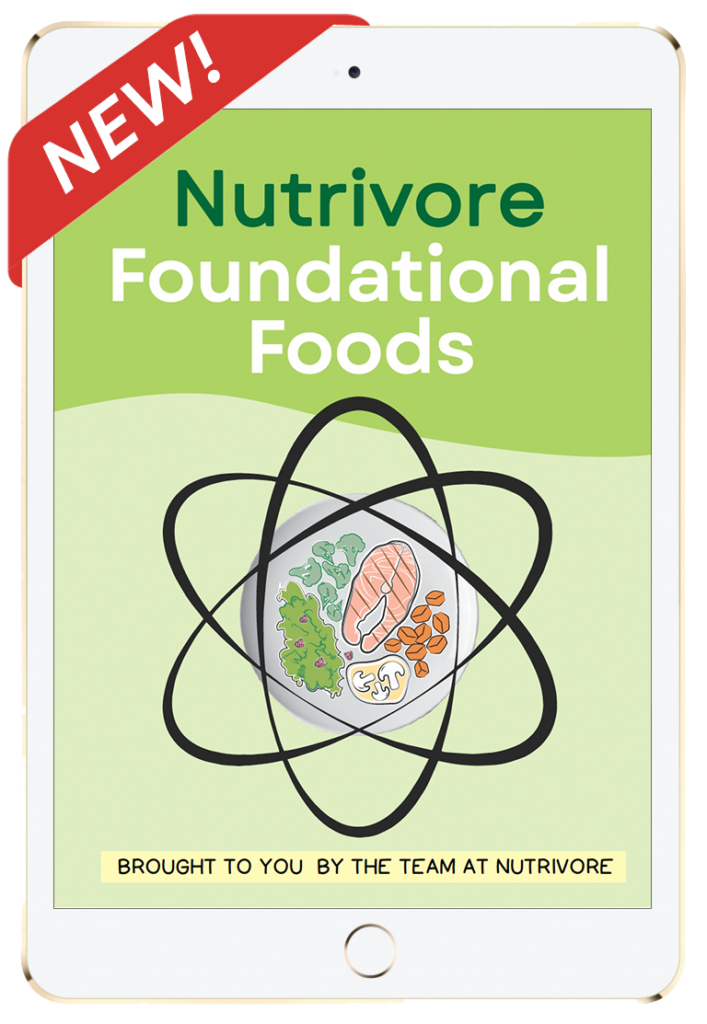
Nutrivore Foundational Foods
Learn what makes the 12 Nutrivore foundational food families nutritionally unique, their health benefits, which options are the most nutrient dense, how much of them to eat, plus various fun facts, practical pointers, and busting of common myths.
This very helpful resource will introduce you to new foods and expand your nutrition knowledge, making food choices easier!
Buy now for instant digital access.
Nutrivore Score for Cauliflower – 1585

Cauliflower has a Nutrivore Score of 1585, making it a super nutrient-dense food! Plus, it is a low-carb and low-calorie-density food; the calorie count of cauliflower is just 27 calories per cup!
Per serving, cauliflower is a best source (>50% daily value) of glucosinolates, vitamin B7 (biotin) and vitamin C; is an excellent source (20-50% daily value) of polyphenols; and is a good source (10-20% daily value) of CoQ10, vitamin B5 (pantothenic acid), vitamin B6 (pyridoxine), vitamin B9 (folate), and vitamin K.
Ditch Diets. Embrace Nutrients. Start with this FREE Guide.
Sign up for the free Nutrivore Newsletter, your weekly, science-backed guide to improving health through nutrient-rich foods — without dieting harder —and get the Beginner’s Guide to Nutrivore delivered straight to your inbox!

Cauliflower Nutrition Facts
One serving of cauliflower is standardized to 1 cup, chopped, or about 107 grams (3.8 ounces). To put this into perspective, 1 medium head of cauliflower (5 – 6 ” diameter) is roughly 588 grams. When you cook cauliflower, it reduces in volume: one cup raw cauliflower is equivalent to a little less than 3/4 cup boiled cauliflower.
Cauliflower Nutrition Facts Per Serving
| Cauliflower, raw | Nutrivore Score: 1585 | Nutrient Density: Super! |
|---|---|---|
| Serving Size: 1 cup, chopped (107 grams) | Protein: 2.1 grams | Net Carbohydrates: 3.2 grams |
| Calories: 27 | Total Fat: 0.3 grams | Dietary Fiber: 2.1 grams |
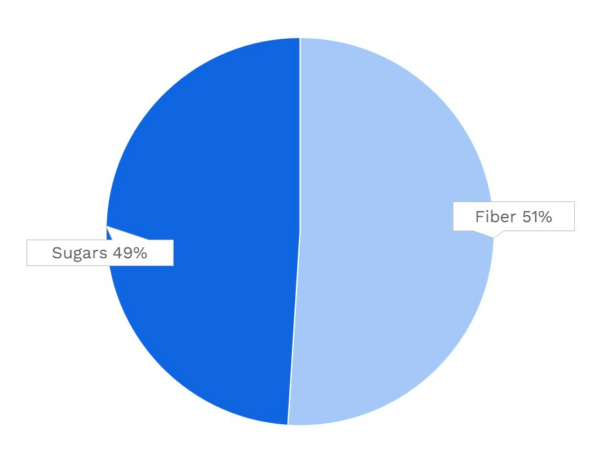
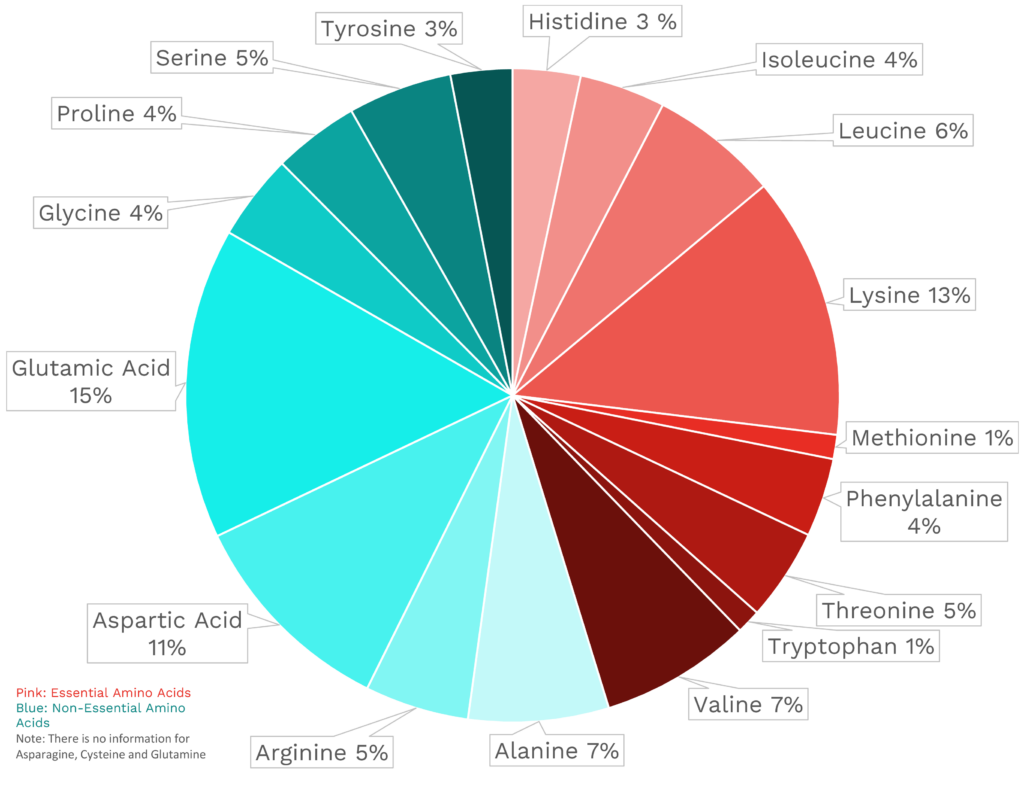
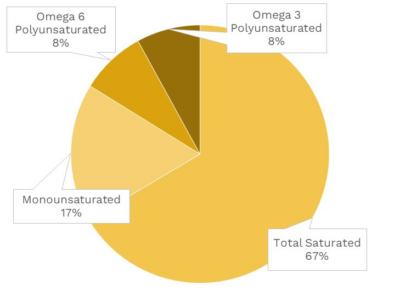
| VITAMINS | ||
|---|---|---|
| Vitamin A | 0.0 μg RAE | 0% DV |
| Vitamin B1 (Thiamin) | 53.5 μg | 4% DV |
| Vitamin B2 (Riboflavin) | 64.2 μg | 5% DV |
| Vitamin B3 (Niacin) | 0.5 mg | 3% DV |
| Vitamin B5 (Pantothenic Acid) | 0.7 mg | 14% DV |
| Vitamin B6 (Pyridoxine) | 196.9 μg | 12% DV |
| Vitamin B7 (Biotin) | 18.2 μg | 61% DV |
| Vitamin B9 (Folate) | 61.0 μg | 15% DV |
| Vitamin B12 (Cobalamin) | 0.0 μg | 0% DV |
| Vitamin C | 51.6 mg | 57% DV |
| Vitamin D (D2 + D3) | 0.0 μg | 0% DV |
| Vitamin E | 0.3 mg | 2% DV |
| Vitamin K | 16.6 μg | 14% DV |
| Choline | 47.4 mg | 9% DV |
| Myo-Inositol | 19.3 mg | ~ |
| CoQ10 | 0.7 mg | ~ |
| FUNCTIONAL FATS | ||
|---|---|---|
| MUFA | 0.0 g | 0% DV |
| ALA | 16.1 mg | 1% DV |
| EPA + DHA | 0.0 mg | 0% DV |
| CLA | 3.2 mg | ~ |
| Linoleic Acid | 0.0 g | 0% DV |
| MCT’s | 0.0 g | ~ |
| MINERALS | ||
|---|---|---|
| Calcium | 23.5 mg | 2% DV |
| Copper | 41.7 μg | 5% DV |
| Iodine | ~ | ~ |
| Iron | 0.4 mg | 2% DV |
| Magnesium | 16.1 mg | 4% DV |
| Manganese | 165.9 μg | 7% DV |
| Phosphorus | 47.1 mg | 4% DV |
| Potassium | 319.9 mg | 7% DV |
| Selenium | 0.6 μg | 1% DV |
| Sodium | 32.1 mg | 1% DV |
| Zinc | 0.3 mg | 3% DV |
| PHYTONUTRIENTS | ||
|---|---|---|
| Carotenoids | 1.1 μg | ~ |
| Polyphenols | 293.2 mg | ~ |
| Phytosterols | 45.8 mg | ~ |
| Glucosinolates | 84.1 mg | ~ |
| Thiosulfinates | ~ | ~ |
| Betalains | ~ | ~ |
| AMINO ACIDS & PEPTIDES | ||
|---|---|---|
| Taurine | ~ | ~ |
| Ergothioneine | ~ | ~ |
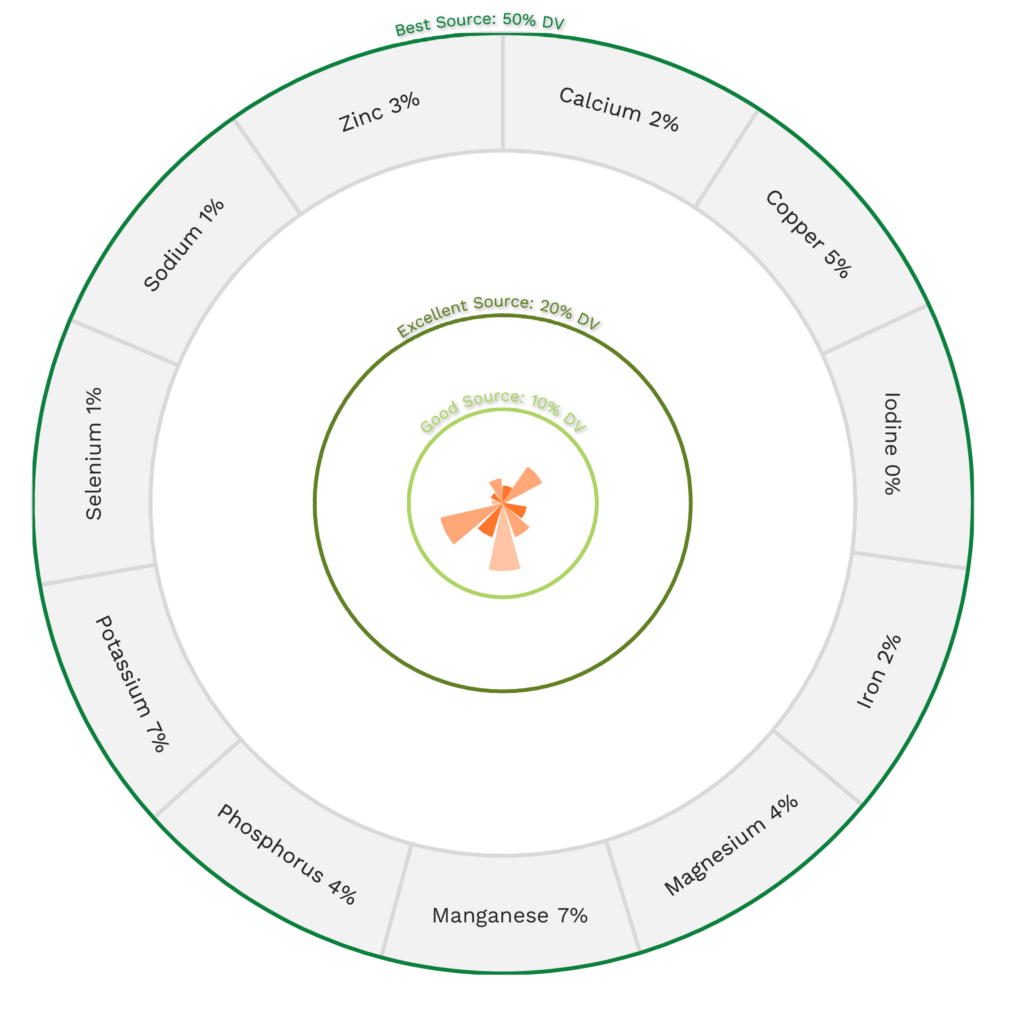
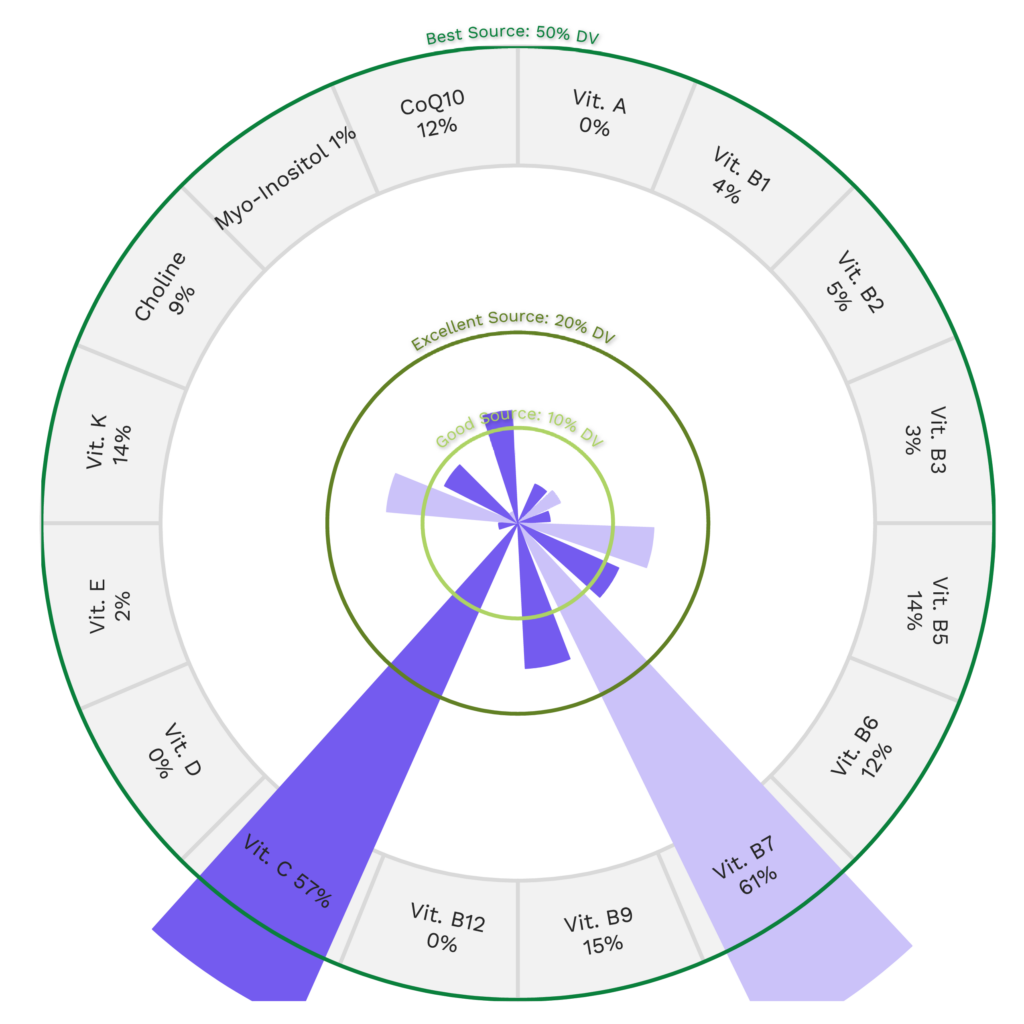
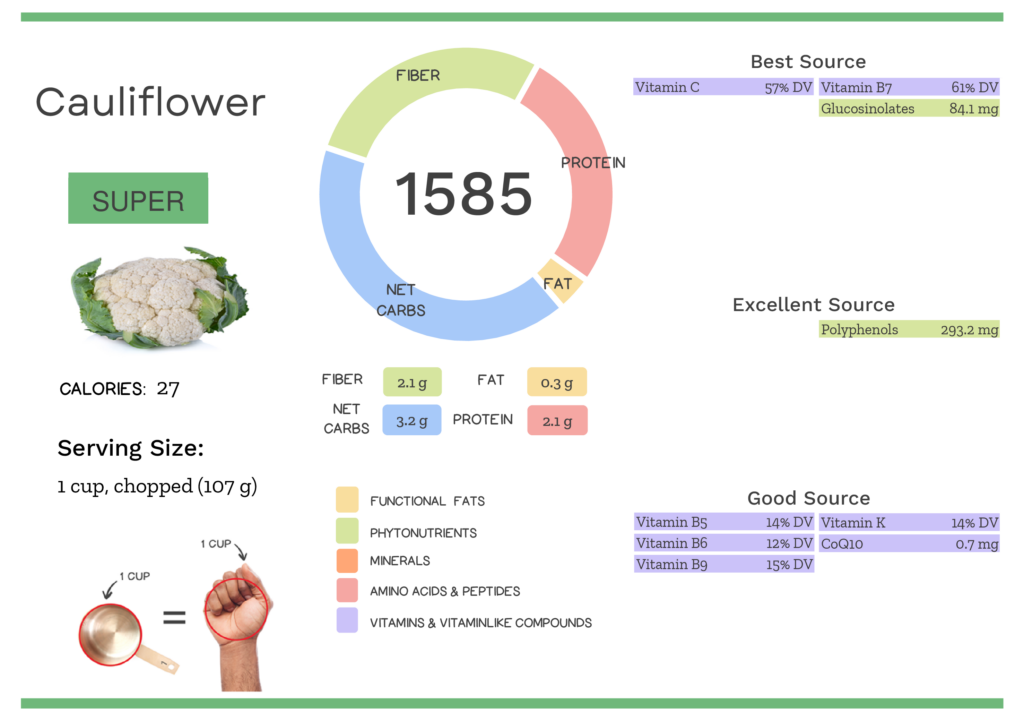
Cauliflower Nutrition Varies With Cooking, Processing & Variety
The Nutrivore Score of cauliflower varies depending on processing, method of preparation, and variety.
| NUTRIVORE SCORE | |
|---|---|
| Cauliflower, cooked, boiled, drained, with salt | 1571 |
| Cauliflower, cooked, boiled, drained, without salt | 1571 |
| Cauliflower, frozen, cooked, boiled, drained, with salt | 1596 |
| Cauliflower, frozen, cooked, boiled, drained, without salt | 1523 |
| Cauliflower, frozen, unprepared | 1574 |
| Cauliflower, green, cooked, with salt | 1383 |
| Cauliflower, green, cooked, without salt | 1383 |
| Cauliflower, green, raw | 1483 |
| Cauliflower, raw | 1585 |
Surprised that cauliflower is THAT nutritious? Maybe your friends will be too!
Health Benefits of Cauliflower Nutrients
Let’s take a closer look at all of the best and excellent source of nutrients found in a 1-cup serving of cauliflower and see how they benefit our health.
Cauliflower Provides 84.1 mg of Glucosinolates
Cauliflower is a fantastic source of glucosinolates, providing 84.1 mg glucosinolates per 1-cup serving!
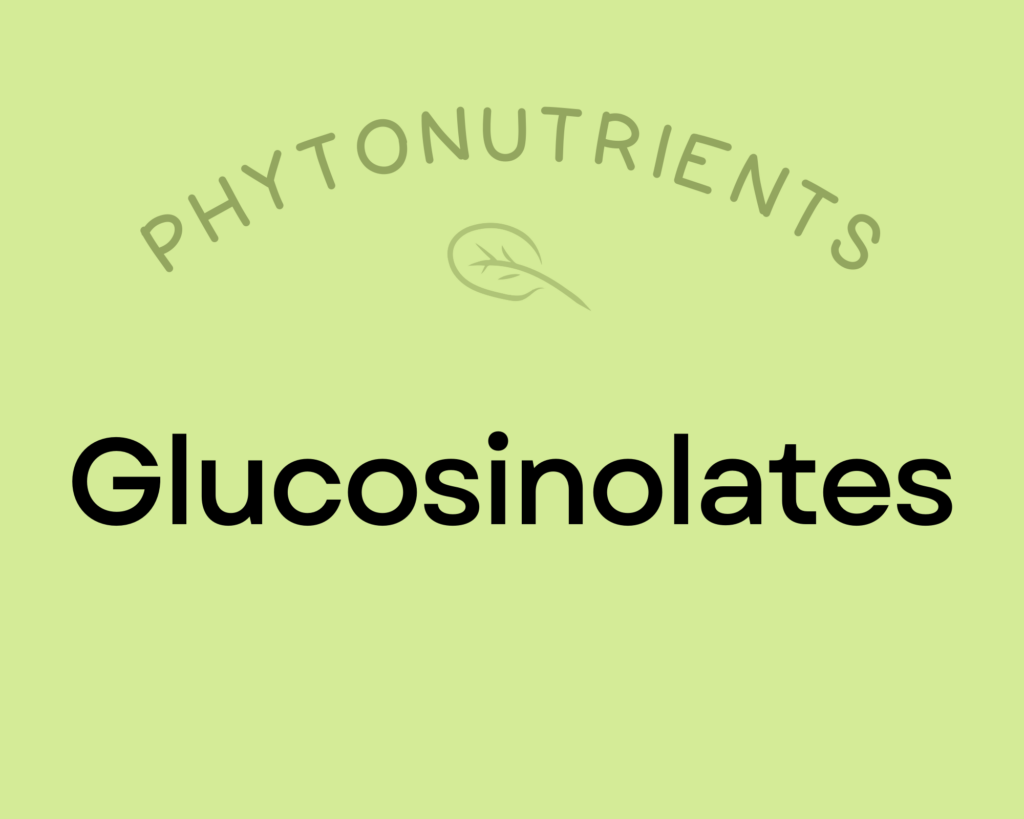
Glucosinolates are well-studied sulfur-containing compounds which break down into bioactive isothiocyanates and indoles when vegetables are damaged (via chewing, cutting, or other processing).
Isothiocyanates (like sulforaphane) are absolute rock stars as far as human health is concerned! Research spanning human epidemiology, animal models, and in vitro experiments show that dietary isothiocyanates are inversely associated with bladder cancer, lung cancer, colon cancer, breast cancer, and pancreatic cancer; some evidence also suggests they may be able to improve ventricular function following heart attacks.
Indoles also have powerful cancer prevention benefits through multiple mechanisms that include modulation of phases I and II detoxification enzymes, regulation of cell cycle arrest, control of cell growth, induction of apoptosis, antioxidant activity, anti-angiogenic effects, and epigenetic regulation. Indole-3-carbinol breaks down into 3,3′-Diindolylmethane (DIM), which is known for its anti-inflammatory, immune system modulating, cancer prevention and estrogen metabolism benefits.
Learn more about glucosinolates here.
Cauliflower Provides 61% DV Vitamin B7 (Biotin)
Cauliflower is a fantastic source of vitamin B7 (biotin), providing 61% of the daily value per 1-cup serving!
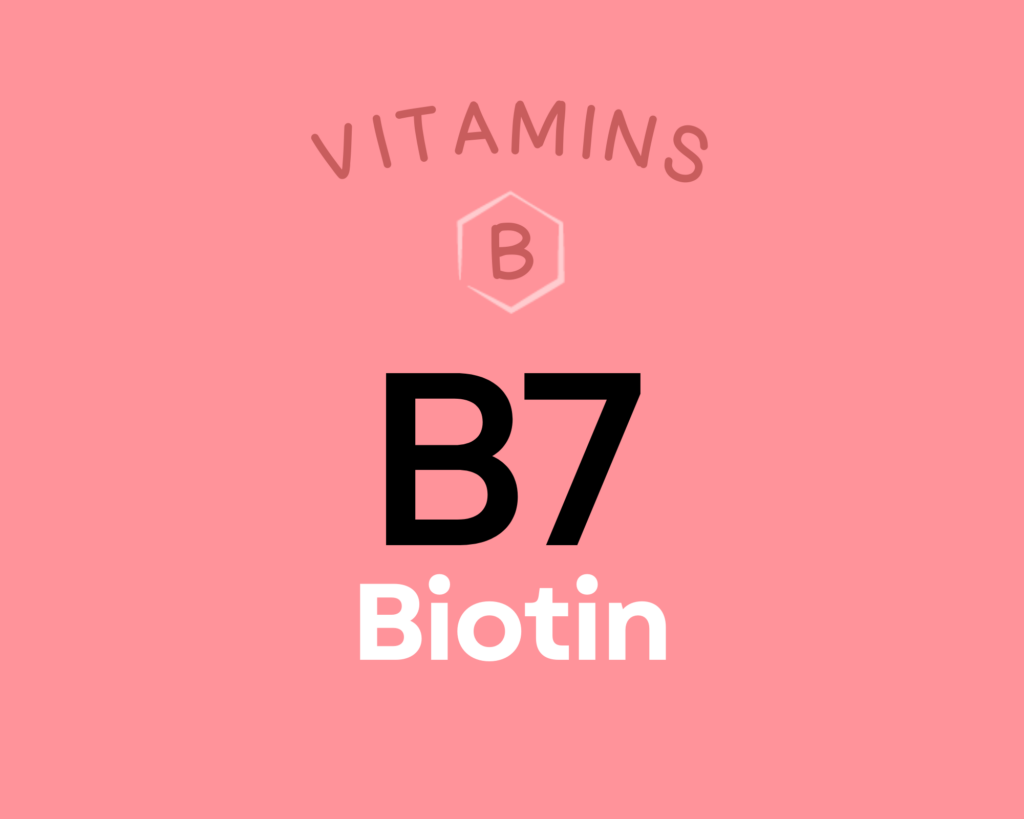
Biotin is a water-soluble B vitamin, also known as vitamin B7. Like other B vitamins, it plays an important role in energy metabolism (serving as a coenzyme for five carboxylase enzymes), neurotransmitter production, cellular function, and the function of various organs. Getting enough biotin can help support healthy nail and hair growth. It’s also particularly important during pregnancy, with low intakes increasing the risk of premature delivery and birth defects. There’s even some evidence biotin can benefit diabetics and reduce functional disabilities in people with multiple sclerosis. Learn more about biotin here.
Cauliflower Provides 57% DV Vitamin C
Cauliflower is also a rich source of vitamin C, providing 57% of the daily value per 1-cup serving!
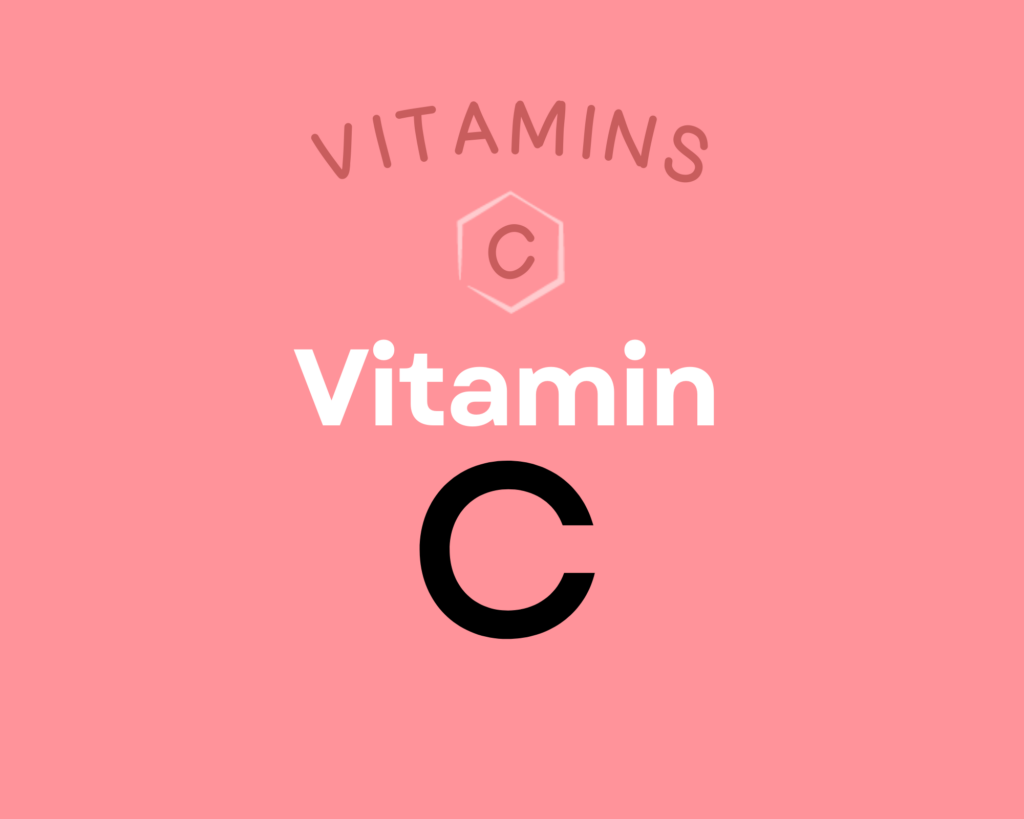
Vitamin C is a water-soluble vitamin that has powerful antioxidant properties (meaning it can help combat oxidative damage from free radicals and reactive oxygen species) and that serves as an enzyme cofactor (meaning it’s needed for enzymes to do their job, for example vitamin C is necessary for collagen synthesis, which is essential for bones, joints, teeth, blood vessels, skin and eyes) and playing important roles in immune system and skin health. Higher intakes of vitamin C are linked to reduced risk of heart disease, some forms of cancer, type 2 diabetes, cataracts, age-related macular degeneration, and gout. Vitamin C can also help regulate the stress response and reduce anxiety, and there’s preliminary evidence that it may also help prevent Alzheimer’s disease. Learn more about vitamin C here.
Cauliflower Provides 293.2 mg of Polyphenols
Cauliflower is an excellent source of polyphenols, providing 293.2 mg of polyphenols per 1-cup serving!
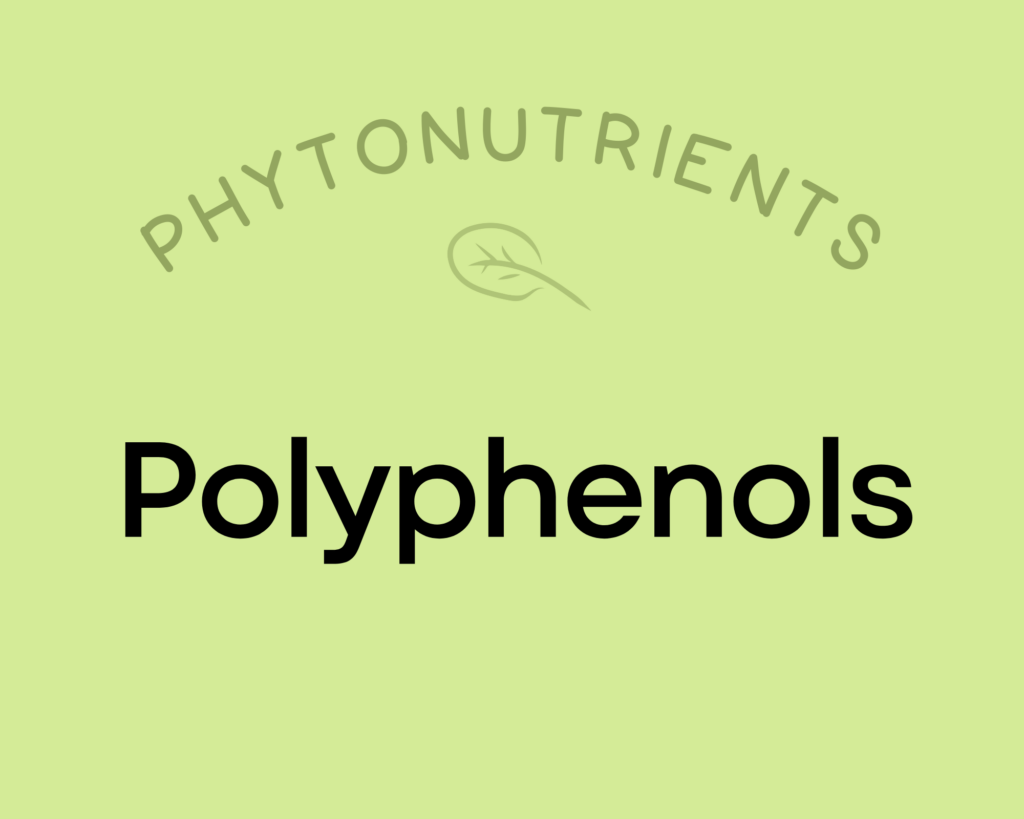
Polyphenols play a huge role in protecting against cancer, heart disease, diabetes, asthma, osteoporosis, neurodegenerative diseases, and other conditions associated with oxidative stress. In fact, a major reason foods like red wine and olive oil (as well as diets rich in both, such as the Mediterranean diet) show up as so beneficial may be due to their high polyphenol content! Along with chronic diseases, supplementing with polyphenols has been shown to protect against infections and reduce the signs of aging. Polyphenols exert their most potent effects by acting as antioxidants—preventing cellular damage by neutralizing hazardous oxygen radicals and improving cellular health as a result (which, in turn, benefits virtually every system in the body). As a result of their antioxidant properties, polyphenols also boost the immune system and protect against both chronic and acute diseases. In addition, polyphenols can help regulate enzyme function, stimulate cell receptors, modulate the functions of inflammatory cells (including T and B lymphocytes, macrophages, platelets, and natural killer cells), alter adhesion molecule expression, affect nerve cells and cardiac muscle cells, and exert antiviral effects. Learn more about polyphenols here.
Learn What Foods Are the Best Sources of Every Nutrient

The Top 25 Foods for Every Nutrient
The Top 25 Foods for Every Nutrient e-book is a well-organized, easy-to-use, grocery store-friendly guide to help you choose foods that fit your needs of 43 important nutrients while creating a balanced nutrient-dense diet.
Get two “Top 25” food lists for each nutrient, plus you’ll find RDA charts for everyone, informative visuals, fun facts, serving sizes and the 58 foods that are Nutrient Super Stars!
Buy now for instant digital access.
How Much Cauliflower Should We Eat Per Day?
You know the old aphorism, a Brassica vegetable a day keeps the doctor away! Wait, that’s not how it goes? It should be!
Every serving of fresh, whole vegetables or fruit we eat daily reduces the risk of all-cause mortality by 5% to 8%, with the greatest risk reduction seen when we consume five or more servings per day. In fact, consuming 800 grams of vegetables and fruits daily reduces all-cause mortality by 31% compared to eating less than 40 grams daily. A 2017 meta-analysis showed that 2.24 million deaths from cardiovascular disease, 660,000 deaths from cancer, and 7.8 million deaths from all causes could be avoided globally each year if everyone consumed 800 grams of veggies and fruits every day.
Eating vegetables and fruit in abundance lowers risk of cancer, cardiovascular disease, type 2 diabetes, obesity, chronic kidney disease, osteoporosis and bone fragility fractures (including hip fracture), cognitive impairment and dementia (including Alzheimer’s disease), neurodegenerative diseases, asthma, allergies, chronic obstructive pulmonary disease, age-related macular degeneration, cataracts, glaucoma, depression, ulcerative colitis and Crohn’s disease, rheumatoid arthritis, inflammatory polyarthritis, non-alcoholic fatty liver disease, acne, seborrheic dermatitis, and lowers markers of inflammation. Learn more in Importance of Vegetables and Fruit.
Covering half of your plate with a variety of vegetables (and three quarters of your plate if your starchy food is a root vegetable or winter squash) at each meal is a simple way to easily achieve the goal of 5 or more servings of vegetables daily.
Studies show that, for every 100 grams of cruciferous veggies (like cauliflower), we eat daily, all-cause mortality decreases by 24%!
Just remember, it’s always best to mix up the veggies you eat day to day (aiming for a wide variety of different vegetables and fruits throughout the week), and cauliflower definitely has a place at the table.
Easily track your servings of Nutrivore Foundational Foods!

The Nutrivore Weekly Serving Matrix
The Nutrivore Weekly Serving Matrix digital resource is an easy-to-use and flexible weekly checklist designed to help you maximize nutrient-density and meet serving suggestions of Nutrivore foundational foods, all without having to weigh or measure your foods!
Includes a 22-page instructional guide and downloadable interactive guides.
Buy now for instant digital access.
Citations
Expand to see all scientific references for this article.
Clements RS Jr, Darnell B. Myo-inositol content of common foods: development of a high-myo-inositol diet. Am J Clin Nutr. 1980 Sep;33(9):1954-67. doi: 10.1093/ajcn/33.9.1954. PMID: 7416064.
Han JH, Yang YX, Feng MY. Contents of phytosterols in vegetables and fruits commonly consumed in China. Biomed Environ Sci. 2008 Dec;21(6):449-53. doi: 10.1016/S0895-3988(09)60001-5. PMID: 19263798.
Kubo H, Fujii K, Kawabe T, Matsumoto S, Kishida H, Hosoe K. Food content of ubiquinol-10 and ubiquinone-10 in the Japanese diet. Journal of Food Composition and Analysis. 2008. Vol 21(3):199-210. https://doi.org/10.1016/j.jfca.2007.10.003.
McNaughton SA, Marks GC. Development of a food composition database for the estimation of dietary intakes of glucosinolates, the biologically active constituents of cruciferous vegetables. Br J Nutr. 2003 Sep;90(3):687-97. doi: 10.1079/bjn2003917. PMID: 13129476.
Phenol-Explorer: Cauliflower, raw
Possenti, M, Baima S, Raffo A, Durazzo A, Giusti AM, Natella F. Glucosinolates in Food. Glucosinolates. 2016. 1-46. doi: 10.1007/978-3-319-26479-0_4-1.
USDA Food Central Database: Cauliflower, raw
Watanabe T, Kioka M, Fukushima A, Morimoto M, Sawamura H. Biotin content table of select foods and biotin intake in Japanese. Int J Anal Bio-Sci. 2014. Vol 2(4):109-125.


